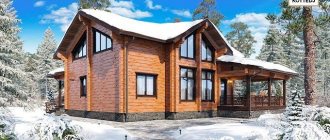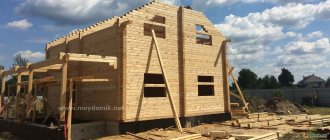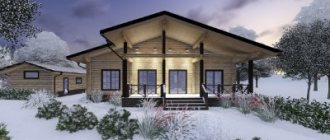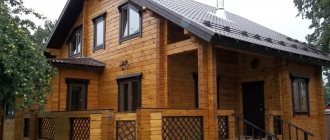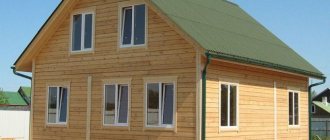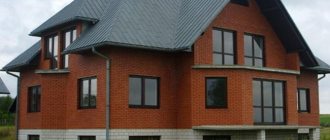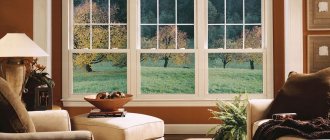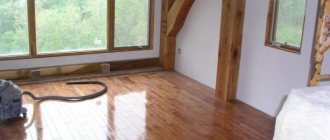In the modern world, it is very fashionable to build houses from wood. But the wide range of such products sometimes leads to people not knowing what is best for them. Today, such material as laminated veneer lumber is not inferior in competition.
It has excellent performance characteristics: high strength, no cracks on the surface, no deformation. In addition, such wood is characterized by low thermal conductivity, therefore, in winter it will be very warm here, but in extreme heat, residents will feel cool.
New generation material – laminated veneer lumber
Most people, especially the population of megacities, dream of environmentally friendly housing and better living conditions. Today, traditions going back centuries, coupled with the latest technological processes, make it possible to build wooden houses of excellent quality. Glued laminated timber is the most in demand and popular in the construction of houses, as it is natural, durable and aesthetically pleasing. Such buildings practically do not shrink, have a long service life and are ready for use and finishing immediately after completion of installation work.
Recommendations for choosing products
To purchase the most reliable and safe laminated veneer lumber, you need to take into account the following factors:
- type of gluing of products;
- the number of lamellas, taking into account the thickness of the timber;
- quality of elaboration of the front sides;
- presence and specificity of trimming;
- use of certified adhesive composition;
- reviews about the manufacturer and supplier;
- Possibility of additional ordering if needs change.
These criteria will help you purchase materials with maximum service life. If you strictly adhere to construction technology, you can build a house that will become a cozy home for several generations.
Production Features
The building material we are considering is made this way: logs are radially sawn into boards, which are subsequently well dried (taking into account the type of wood), to approximately 10-12% humidity, and mechanically processed, as a result of which all possible defects are removed. After high-quality drying, the wood undergoes a visual inspection to detect and eliminate areas with dead knots, resin pockets and fungal infections.
Then the boards (otherwise called lamellas) are glued together with special compounds and according to a technology specific to such a material. There can be several of them in the finished timber; the length of the blanks can reach up to 18 meters. Next, the wooden beams are dried, and only after that the laminated veneer lumber is calibrated, that is, it acquires its usual rectangular shape.
Advantages of laminated veneer lumber
Like any building material, laminated veneer lumber has advantages and disadvantages. First, let's look at its advantages:
1. Houses made of laminated veneer lumber are easy to install and assemble, and shrinkage and shrinkage are kept to a minimum.
2. The material practically does not deform and does not change its shape.
3. During operation, it does not become cracked. Its surface is flat and smooth, requiring no additional processing or labor-intensive and expensive finishing work.
4. Glued laminated timber has optimal humidity, which prevents rotting and the appearance of fungal microorganisms and harmful bacteria in it.
5. This material can be used to implement very complex projects.
Small terms for building premises
Ordinary brick houses take several years to build, and the entire period of work requires constant investment.
During the cold season, construction is either interrupted or at least uncomfortable, you need to constantly find workers, and a lot of time is spent on finishing work.
In the case of building a house from timber, the entire process of constructing the building will take no more than a few months.
Sometimes it is possible to complete a full cycle of work in 40-50 days.
The house is designed so carefully and in detail, then each beam is manufactured in strict accordance with the drawings, that all that is required of the workers at the site is to assemble the building, like a constructor.
And it doesn’t matter which house project you choose - on the right or left photo, any option will be manufactured and assembled as quickly as possible
In fact, this is one of the main reasons many people choose this option.
Minuses
However, it cannot be said that laminated veneer lumber is distinguished by positive characteristics alone. There are also disadvantages, here are some of them:
1. High price for glued material. Such a house will cost 2 times more than buildings made from non-profiled logs.
2. Due to the fact that the manufacturing technology is quite new, data on the behavior of this material over long periods of time (for example, after 30-50 years) are not yet available, since its properties have not yet been studied.
3. Use of glue in the production process. Despite the fact that the adhesive compositions comply with the standards, in terms of environmental friendliness, laminated veneer lumber will be inferior to ordinary profiled timber or logs, since they completely lack such substances. The use of glue worsens some characteristics; in any case, air exchange and moisture circulation do not occur fully. In addition, the indoor microclimate is also disrupted.
Standard or individual project?
At the beginning of any construction, a project is selected. Design allows you to competently plan the space and calculate the cost of work. Construction without a project takes longer and does not guarantee results. At such construction sites, all issues are resolved during the construction of the structure, which is completely ineffective. Before placing an order to create a house project, you need to determine its type. You can choose a standard project or order an individual development with a detailed plan.
- Typical. Standard designs that have most likely already been used in the construction of other buildings. They are completely suitable for work and can be agreed upon by different authorities. Such a project is suitable if the construction budget is limited and the cost of the project is important. You can also choose a standard plan if you don’t have time to wait for a custom plan. If you do not plan to live in the house all year round, then a conventional layout will also suffice. Standard projects have certain disadvantages. For example, they may not be suitable for certain landscapes or specific sizes. Also, the layout of the premises does not always coincide with the wishes of the future owners.
- Individual. By ordering such a layout, you receive guarantees that the architects will take into account any of your requirements. Each step in the development of such a project is discussed with the customer. A specialist creates a functional structure for living all year round. This design method is suitable if nothing in the catalogs with standard projects suits you. Also, an individual plan is relevant for customers who already have a clear idea of their ideal home. It happens that standard buildings (small or non-standard plots of land) cannot be placed on the territory. In this case, individual design will also be required. The disadvantages of this solution include the high price of architects' services. It also takes a lot of time to create such a project.
What is the reason for the high price of building materials?
Despite the fact that the desire to live in a house made of natural materials is very great, many are deterred by their cost. Indeed, laminated veneer lumber, the disadvantages of which were discussed a little higher, is more expensive than all conventional analogues made of wood - rounded logs, ordinary timber, etc.
The high cost of such material is undoubtedly influenced by the rather complex process of its production. Production costs, cycles, consumption of wood and resources increase, which cannot but affect the cost.
High-quality laminated veneer lumber, of course, has shortcomings, and all of them lie where there is unfair production, irresponsibility, inattention, negligence when choosing equipment and raw materials, etc. Some people use not very high-quality materials in their work, thereby trying to save money and simplify the manufacturing process. However, the homeowner will soon regret this, as his house will literally begin to fall apart and collapse. On the other hand, real laminated veneer lumber is practically not subject to deformation; it is more durable compared to other lumber. It turns out that the inflated price is completely justified. But the low cost, on the contrary, should alert you.
Flaws
The main disadvantage of such houses is their high cost.
In this case, you won’t be able to save money, since high-quality laminated veneer lumber cannot be cheap, and if there are such offers, then most likely the technology was not followed during the production process. And if the technological process is disrupted, then you can’t even dream about the strength of a house made of laminated veneer lumber. The manufacturer can also save on the adhesive mixture and use glue with the addition of phenol, which immediately affects the environmental characteristics of the house.
Also, houses made of laminated veneer lumber will require regular maintenance. Every spring, the facade of the house will have to be treated with special impregnating mixtures to prevent discoloration and increased aging.
Glued laminated timber is becoming increasingly in demand in suburban construction. The rapidly growing popularity of this material is explained by its excellent performance characteristics, aesthetic appearance, environmental safety and long service life, as well as the absence of shrinkage and a number of other advantages, which we will discuss in detail in this article.
Is laminated veneer lumber safe?
There are often disagreements about the safety of materials such as laminated veneer lumber for humans and the environment. The reason for this controversy is the use of glue in the manufacturing process.
Here you need to take into account that the substances used in the manufacture of such timber consist of natural-based materials. In some ways, glue can be compared to wood resin, which is more durable and resistant to various influences. But since laminated veneer lumber, the advantages and disadvantages of which we have already examined, consists of several boards glued together, there is no need to talk about good movement of moisture and air. Accordingly, we can draw the following conclusion: it is not as useful as solid wood, but it cannot be called harmful either, since all materials used for its production are necessarily certified.
According to statistics, many ordinary homeowners and construction companies choose laminated veneer lumber. Disadvantages (reviews about the use of this material confirm this), of course, affect some properties of wood, but this is not critical.
conclusions
Glued laminated timber is a building material with excellent performance properties. But when purchasing it, it is very important to avoid dubious offers and cooperate only with reliable, well-established manufacturers who value their reputation. When collaborating with the construction production company Greenside, you will not have to doubt the quality of the building materials used, and you will be able to fully appreciate all the advantages of houses made of laminated veneer lumber!
It has always been believed that wood is the most suitable material for construction. It's all about its environmental friendliness, low thermal conductivity, naturalness and, of course, natural beauty. This building material has very few disadvantages, and people have learned to deal effectively with those that exist.
Varieties
There are different types of this material. Depending on the design and purpose, they can be divided into 2 groups:
1. Building materials for the construction of walls (for this, insulated or ordinary laminated veneer lumber is used).
2. Materials for the construction of individual structures (bent laminated veneer lumber and window beams, floor beams, etc.). The most popular are the Finnish and German types. Scandinavian laminated veneer lumber, the only disadvantage of which is that it requires the use of additional compaction (and in general it is a common type of profile), differs from the rest in the presence of two side tenons and special grooves. Such products are connected with a strong lock, and in the middle there is a place for laying the seal. The German profile is recognized by its comb-shaped connection. It provides maximum density without the use of sealing material.
Difference from usual
If we draw an analogy between these two materials, then there is not much difference between them. The first is the profile shape. In ordinary material it takes the form of a rectangle or square, in glued material it takes the form of a complex geometry. In addition, minor elements play an important role in determining the properties of these lumber.
You can find out which is better than logs or laminated veneer lumber from the article here.
The next difference is the cost. There is a big difference in price between regular and laminated timber. For example, the average cost of ordinary timber per m3 will be 7,000-9,000 rubles, but laminated timber – 18,000-24,000 rubles. Which option is right for you is up to you to decide.
In this article you can learn how to make a wooden floor in a house.
The video shows the advantages of laminated veneer lumber over regular timber:
